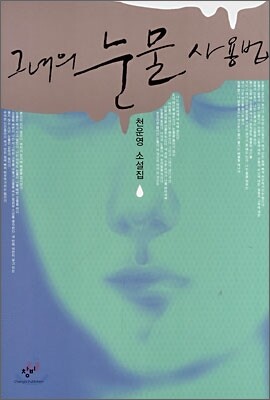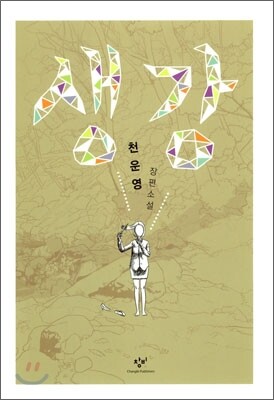Cheon Un-yeong (born 1971) is a South Korean writer.
Life
Cheon was born in Seoul in 1971. She studied journalism at Hanyang University and creative writing at Seoul Institute of the Arts and Korea University Graduate School. She made her literary debut in 2000, winning the Dong-a Ilbo New Writer's Award with the short story "Baneul" (바늘 Needle).
Cheon is known for undertaking serious research before writing. For her first short story collection, Baneul, she worked at a livestock market in Majang-dong and at the kitchen of a sushi restaurant for firsthand experience. She also boarded smuggling vessels departing from China several times when writing her first full-length novel, Jal gara, seokeoseu (잘 가라, 서커스 Adieu, Circus).
In 2013, Cheon was selected as the first Korean participant in the Korea-Spain Writer Residence Exchange Program. While in Spain, she read Don Quixote and traveled the country searching for food that appears in the novel, which became the basis for her essay collection Donkihoteui siktak (돈키호테의 식탁 Don Quixote's Table). Back in Seoul, Cheon opened a Spanish restaurant called La Table del Quixote and ran it for two years. She published a collection of essays inspired by the experience, Sseugo dalkomhan jigeop (쓰고 달콤한 직업 A Bittersweet Job).
Cheon has authored the short story collections Baneul, Myeongnang (명랑 Cheerful), Geunyeoui nunmul sayongbeop (그녀의 눈물 사용법 How She Uses Her Tears), Eommado asidasipi (엄마도 아시다시피 As You Know, Mom) and the novels Jal Gara, Seokeoseu and Saenggang (생강 Ginger). She is the recipient of the Shin Dong-yup Prize for Literature (2003) and the Annual Arts Award (2004).
Writing
Cheon’s stories depart significantly from such thematic concerns as love, extra-marital affairs, and urban or middle-class sensibilities that characterized many of the fictional works by women in the 90s. The women in Cheon’s fictional world are defined not by their reaction to the traditional views of women but by their hedonistic tendencies and the feral, primeval instincts they possess. Such a vision of womanhood is often expressed through visceral and visually shocking images.
"Sum" (숨 Breath) features an old woman who works at a butcher’s shop and relishes every part of the cows she dresses out for sale. She eats pieces of raw cow brain as a delicacy; she believes liver is a cure for dizziness and entrails, for indigestion. Her love for meat is taken to its grotesque extreme when she begins hankering for the taste of cow fetus.
In "Baneul," the protagonist is a tattooist who enjoys watching the first drop of blood oozing from skin. Female aggression embodied in the act of tattooing is contrasted against emasculated manhood symbolized by a monk whose murder provides the mystery that drives the narrative forward. Cheon locates the source of such aggression in the prolonged state of oppression, alienation or fear.
In "Dangsinui bada"(당신의 바다 Your Ocean), violent images of writhing eels being skinned alive accentuate the protagonist’s feeling of abandonment due to his father’s absence. Aggressive, animalistic behaviors are a defense mechanism triggered by the harsh reality, Cheon tells us.
The main strategy of Cheon's writing is to unveil issues in Korean society by fictionalizing the process of overturning traditional values and discovering identity through these characters. She is credited with introducing new feminist aesthetics with unique female characters, while paying attention to existential solidarity.
Cheon un-young wurde 1971 in Seoul geboren. Ihre Kindheit verbrachte sie meist alleine, weshalb sie sich bereits früh mit Literatur in Form von Märchen zu beschäftigen begann. Die Erzählung Die Nadel und andere Erzählungen aus dieser Zeit ordneten Cheon als eine Vertreterin einer neuen Generation feministischer Autorinnen ein. Die Selbstfindung der Frau in der Gesellschaft ist nicht mehr das zentrale Thema. Auch die Frage, was von dem traditionellen Familienbild noch erhalten bleibt, stellt sich nicht, denn die Familie in ihrer erzählten Welt ist bereits demontiert, und die Überlebenden sind die Frauen. Die weiblichen Charaktere wie beispielsweise in Die Nadel haben ihre eigenen Wege gefunden, sind hedonistisch, stark und besitzen eine Bereitschaft zur Gewalt. Herausragend ist Cheons präzise Beobachtungsweise, mit der sie die Ästhetik ihrer erzählten Welt definiert. Sie ist außerdem für Werke bekannt, die auf sehr extensiver Nachforschung basieren. Ihre Werke erzählen Geschichten, wie sie in der Welt der koreanischen Romane bis jetzt nur selten zu finden sind und erinnern oftmals an eine Dokumentation. Außergewöhnliche Hauptcharaktere, wie eine Tattoo-Stecherin oder seltsame Schauplätze, wie ein Schlachthaus, in dem unschuldige Tiere zum Verzehr verarbeitet werden, hinterlassen beim Leser einen bleibenden Eindruck.
Su obra se aleja de forma significativa de temas como el amor, las relaciones extramatrimoniales y los asuntos de clase media urbana que caracterizan muchas de las obras de ficción de las escritoras en los noventa. Las mujeres en el mundo de ficción de Cheon Un-yeong no están definidas por el modo en que reaccionan a la manera tradicional en que son vistas y tratadas las mujeres, sino por sus tendencias hedonistas y sus instintos primitivos. Esa visión de la mujer se expresa a menudo a través de imágenes viscerales y sorprendentes. "Respiración" trata de una mujer mayor que trabaja en una carnicería y saborea con entusiasmo cada una de las partes de la carne de vaca que tiene a la venta. Come trozos crudos del cerebro vacuno como si fuera un manjar, cree que el hígado es una cura para el mareo y los intestinos lo son para la indigestión. Su pasión por la carne es llevada al extremo más grotesco cuando empieza a desear probar el feto de una vaca. En "La aguja", la protagonista es una tatuadora que disfruta viendo brotar la primera gota de sangre de la piel. La agresión femenina personificada en el acto de tatuar contrasta con la hombría representada por un monje, cuyo asesinato proporciona el misterio que hace que la narración prosiga.5 Cheon Un-yeong encuentra la fuente de tales agresiones en el prolongado estado de opresión, alienación o miedo. En "La aguja", el trabajo de la protagonista como tatuadora es paralelo el trabajo de su madre como bordadora y apunta a la relación infeliz de su madre con un monje. En "Tu océano", las imágenes violentas de anguilas retorciéndose al ser peladas vivas acentúa el sentimiento de abandono de la protagonista por la ausencia de un padre. Las conductas agresivas son un mecanismo de defensa contra la cruda realidad.
L'Institut coréen de traduction littéraire (LTI of Korea) résume le travail de Cheon de cette manière4 : Les œuvres de Cheon s'écartent considérablement des préoccupations thématiques comme l'amour, les affaires extra-conjugales, les sensibilités urbaines ou les classes moyennes qui ont caractérisé la plupart des œuvres de fiction de la littérature féminine coréenne dans les années 1990. Les femmes dans les romans de Cheon ne sont pas définies comme le veut la tradition coréenne ou par les valeurs confucéennes, mais par leurs tendances hédonistes et leurs instincts primitifs. Une telle vision de la féminité s'exprime souvent à travers des images viscérales et visuellement choquantes. Ainsi Respiration (Sum) met en scène une vieille femme qui travaille dans la boutique d'un boucher et savoure chaque partie des vaches qu'elle met en vente : elle mange des morceaux de cerveau cru de vache comme un mets délicat, elle croit que manger des foies est un remède pour les vertiges et les entrailles un remède pour l'indigestion. Son amour pour la viande est décrite jusqu'à en devenir grotesque, notamment quand elle commence à avoir un penchant pour les fœtus de vache. Dans L'aiguille (Baneul), la protagoniste, une jeune femme est une tatoueuse qui aime regarder la première goutte de sang qui suinte de la peau de son client lors du tatouage. Cheon localise la source de ces agressions et des violences dans les états prolongés de l’oppression, de l'aliénation ou de la peur. Dans L'aiguille (Baneul), le travail de la tatoueuse est mis en parallèle avec le travail de sa mère qui travaillait comme brodeuse, malheureuse de sa relation avec un moine. Cheon affirme que les comportements "animaliers", agressifs, sont un mécanisme de défense déclenché face à la dure réalité du quotidien.
1971年、ソウル特別市に生まれる。2001年『東亜日報』新春文芸に『바늘(針)』が当選し、登壇した。2002年に第9回大山文化財団文学人創作支援金をもらう。2003年に『申東曄文学賞』を、2004年に「今年の文学賞』を受賞した。 千の小説の特徴はまず独特な素材にある。入れ墨をする女性だったり、遊園地のお化け屋敷の管理人、建築労働者などを登場人物とし、 牛を屠殺する風景や精肉店の肉などを驚くほど事実的に描写している。このような描写は千が直接インタビューや取材をして生み出したものである。 もう一つの特徴は、小説に登場する女性の特別さである。彼女たちは伝統的でも受身な姿勢でもなく、また社会に適応したエリートでもない。動物的な本能を持ち、攻撃的な傾向があるが、これは長い間の抑圧と疎外によって生まれたものである。このような主人公たちが従来の価値を覆し自分の欲望に従って新しい自分を見つけていく過程を描くことで、現社会の問題を暴露している。グロテスクな雰囲気と独特な背景設定も千の小説の特徴だ。
生于1971年。大学就读于新闻广播学系文艺创作专业。2000年通过发表短篇小说《针》,开始了创作活动。作者一进入文坛就以其强烈而固执的叙事方式一举赢得了评论界与读者的广泛关注。2005年主要报刊所举办的“新春文艺”评论类入选作品均以千云宁作为评论对象,可见当时对作家的关注之热度。千云宁是在论及21世纪韩国文学新倾向时始终要置于首位的作家,创作了一批惊悚而又体现官能美学的短篇小说,以及经过细致深入的采访而以强烈的故事感见长的长篇小说。2003年获得申东烨创作奖,2004年获得年度艺术奖。著有小说集《针》、《明卵》、《她的眼泪使用法》、《如妈妈所知》,长篇小说《永别了,杂技》、《生姜》等。其中《永别了,杂技》的法译本,《生姜》日译本均已出版,《她的眼泪使用法》则在俄罗斯和中国有译本出版,德译本将于2017年出版。
천운영(1971~ )은 대한민국의 소설가다.
생애
천운영은 1971년 서울에서 태어났다. 어린 시절 혼자 시간을 보낼 때 전래동화책을 반복해서 읽으며 새로운 이야기를 만들어내곤 했다. 한양대학교 신문방송학과를 졸업한 후 서울예술대학 문예창작학과와 고려대학교 대학원에서 수학했다. 2000년 《동아일보》에 소설 〈바늘〉이 당선되어 데뷔했다.
천운영은 철저한 현장 취재를 통해 작품을 쓰는 작가로 알려져 있다. 첫 번째 소설집 《바늘》(2001)에 수록된 단편들을 창작하기 위해 작가는 마장동 축산시장과 횟집 주방에서 실제로 일을 했고, 첫 장편소설 《잘 가라, 서커스》(2005)를 쓸 때는 중국에서 밀수 배에 여러 차례 오르기도 했다.
2013년에는 ‘한국-스페인 작가 레지던스 교환프로그램’의 한국 작가로는 처음으로 참가자로 선정되었다. 스페인에서 지내며 《돈키호테》를 읽은 후 스페인 곳곳을 탐방하며 음식을 연구하였다. 이후 서울에 스페인 음식점 ‘돈키호테의 식탁’을 개업해 1년 넘게 운영했다. 식당 운영 경험을 바탕으로 장편소설 《폐업일기》를 연재하기도 했다.
작품 세계
천운영의 소설 속 주인공들은 훼손된 몸을 가진 여성들이 육식성과 폭력성을 가진 남성과 대비되는 에너지를 발산한다. 작가는 이러한 인물들을 통해 기존의 가치를 전복하고 새로운 정체성을 찾는 과정을 소설화함으로써 여성에게 억압적인 한국 사회의 문제점을 폭로했다. 또한 작가의 소설은 여성의 실존적 연대에 관심을 갖고 이를 바탕으로 새로운 소설적 미학을 구축하고 있으며 그로테스크한 분위기와 독특한 배경 설정도 그러한 방법 중의 하나라고 할 수 있다.
데뷔작인 〈바늘〉(2000)은 문신시술을 하는 여주인공 화자가 바늘로 남성의 몸에 야만적인 상처를 내고 그 위에 자신의 욕망을 그려 넣는 이야기로, 기괴하고 독특한 작품의 분위기로 인해, 한국 소설에서 볼 수 없었던 독특한 야생의 미학을 선보인 것으로 평가받았다.
첫 번째 장편소설 《잘 가라, 서커스》(2005)는 작가가 수차례 중국을 뱃길로 오가며 준비하여 창작한 작품으로, 감각적이고 생생한 문체를 통해 조선족 여인의 애수와 비애의 서사를 담아냈다. 이 작품은 천운영의 다른 소설과 달리 문제의식이나 문법, 문체에서 변화를 보여주었는데, 특히 고통과 상처를 폭로하기 보다는 타자의 상처를 보듬고 있다는 점에서 주목을 받았다.
주요 작품
1) 소설집
《바늘》, 창비, 2001.
《명랑》, 문학과지성사, 2004.
《그녀의 눈물 사용법》, 창비, 2008.
《엄마도 아시다시피》, 문학과지성사, 2013.
2) 장편소설
《잘 가라, 서커스》, 창비, 2005.
《생강》, 창비, 2011.
3) 산문집
《쓰고 달콤한 직업》, 마음산책, 2021.
《돈키호테의 식탁》, 아르테, 2021.
수상 내역
2003년 신동엽창작상
2004년 올해의 예술상




